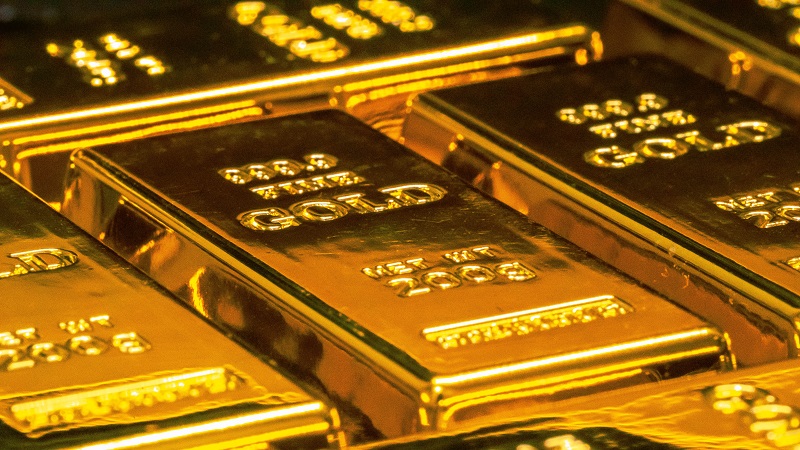Gold has gone from strength to strength in recent years, with the precious metal’s price rising 23.5% in the past six months alone. Yet despite this strong performance, investors are lowering their exposure.
They have steadily been removing money from gold ETFs since 2020, when the total amount held in them peaked at around $110m. That has since dropped about 25% to $82.2m today.
But over the same period, the price of gold has more than doubled (up 56.6%) from $1,921 per ounce at the start of 2020 to its current price of $2,373.
This bucks the trend investors typically follow with a growing asset class – they usually try to capture upside growth rather than pivot away from it.
Less than 10% of advisers are considering increasing their gold exposure, according to a recent Bank of America survey, with 75% holding less than 1% of their portfolios in the precious metal.
There are now concerns that this declining demand could bring the gold rush to a halt, but Shard Capital’s head of research, Ernst Knacke, said it has only just begun.
Uplift from liabilities
Investors who anticipate the gold rally to slowing have failed to consider the strong tailwinds from government liabilities – a driver that could keep boosting the gold price for some time to come, according to Knacke.
Government deficits are at an all-time high and central banks will likely need to print more money in order to fund these liabilities. Fiat currencies should suffer as a consequence, which will support the price of gold in turn.
Knacke pointed out that gold prices have risen far less than most central banks’ soaring liabilities over the past 20 years, leaving the precious metal relatively undervalued by comparison.
“The increase in the price of gold has not held up with the enormous amount of money printed by central banks,” he explained. “Considering more government debt is likely to end up on the balance sheets of central banks, the upper bound for gold is still a long way off.”
See also: Is it too late to take a renewed interest in gold?
Federal debt in the US stands at $34.6trn as of last year, which is a sizable 123% to the nation’s gross domestic product (GDP). That debt-to-GDP ratio is 23 percentage points higher than it was a decade before, and an even steeper 63 percentage point increase over the past 20 years.
In fact, US debt has generally been on the rise since 1981, increasing or remaining the same for 35 of the past 42 years.
But gold’s attractiveness in relation to government liabilities is only one reason to expect an ongoing rally, according to Knacke. Gold is renowned for protecting against uncertainty, which is abundant amid this year’s many elections and geopolitical tensions.
Strengthening demand from Asia
Concerned investors in China and Japan have already began buying gold en masse as a means of shielding their savings from uncertainty.
Those in the west who question the gold rush’s longevity may therefore need to take a broader look at the market, according to George Cheveley, manager of the natural resources strategies at Ninety One.
Investors in China and Japan have been buying gold, but not through ETFs, which is a vehicle mostly used by western institutions and individuals. This could explain why the price of gold continues to rise despite falling demand for ETFs specialising in the precious metal.
See also: Will economic green shoots entice investors back to the UK market?
Cheveley said: “[Chinese and Japanese investors] are attracted to gold as a hedge against weakening currencies, geopolitical risk and diversification from equities, fixed income and real estate asset classes.
“Following the sanctioning of the US dollar in Russia, other countries have been diversifying away from US treasuries in favour of assets such as gold which are liquid and can be held domestically.”
A shiny outlook for gold
Investors in the west may have had little appetite for gold, but they can be forgiven for ignoring the asset class given the opportunities available to them elsewhere, according to Chris Beauchamp, chief market analyst at IG Group.
Strong gains from US stocks last year presented an attractive investment opportunity for those wanting to grow their savings, while decade-high yields in the fixed income space enticed income-seeking investors.
Despite competition from other asset classes, Beauchamp said there is “still plenty of room for gold to move higher” over the long term. Conflict in the Middle East is providing a “solid underpinning” for the precious metal as a hedge against uncertainty, which could be exacerbated by any number of the other tensions in markets this year.
“Gold’s apparent unpopularity has been driven by the better returns on offer in stocks (for capital) and bonds (for income), but the rising price is bound to attract more inflows, in turn driving the price higher,” Beauchamp said.
Given the strong drivers from government liabilities, protection from uncertainty, and demand from Asia, Knacke said that investors should not be so quick to call an end to the rallying gold price.
“The inevitability of financial repression is misunderstood, macroeconomic and geopolitical event risks are under-appreciated, and gold is generally under-owned by institutional and retail investors in the west, whilst the underlying trend remains very strong and robust,” he added.
“All in all, the outlook for gold is as shiny as the metal itself, and we retain significant conviction and exposure.”
See also: AJ Bell: Six companies that could IPO in London this year










